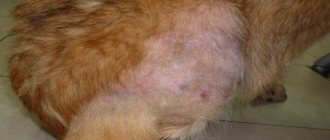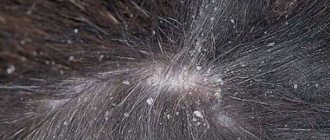Why does a cat go bald: reasons
Baldness (alopecia) leads to the appearance of bare patches of skin on your pet's body.
If there is too much hair, bald spots appear, the animal behaves restlessly
The main reasons for the development of pathology:
- allergic reaction;
- damage by fleas, lice;
- the presence of a scabies parasite;
- otodectosis (ear mites);
- fungal or lichen infections (dermatomycosis, dermatophytosis);
- pyoderma;
- purulent formations on the skin;
- oily seborrhea;
- deficiency or excess of thyroid hormones;
- increased work of the adrenal glands;
- diabetes;
- genetic predisposition;
- stress;
- lack of vitamins;
- chronic diseases of internal organs.
Important! A common cause of alopecia is food allergies. It is not recommended to give pets food from the human table. Veterinarians advise buying specialized food that contains the necessary vitamins and minerals.
Diagnosing the causes of baldness
In order to prescribe treatment for a cat and give its owner recommendations on maintenance, the veterinarian must determine why the bald spot appeared on the neck or paw. The cause is determined by exclusion; this approach requires professionalism from the doctor and attentiveness from the cat’s owner.
INTERESTING! If a problem with fur occurs, you need to carefully examine the cat, its fur and skin. If a cat that has hair on its hind legs has a rash elsewhere on its skin, either small or large, a diagnosis of allergic dermatitis may be possible.
With allergies, the pet owner may experience watery eyes, sneezing, and hair falling out in large clumps. The specialist will prescribe comprehensive treatment.
Such severe baldness is usually observed during an acute allergic reaction. Without eliminating the cause of the allergy, it will not be possible to cope with wool problems.
Symptoms of hair loss in cats
A healthy cat should have soft and silky fur.
Partial alopecia on the back of a cat
Severe hair loss requires treatment. Alopecia usually begins to manifest itself with the appearance of bald spots on a cat in one area of the body, and other areas of baldness gradually appear.
The skin at the site of loss may be rough and red with small wounds. If the area of a cat’s bald spot is painful or itchy, the animal reacts aggressively to touch.
Consequences of injury
Observing a cat after it has fallen and been severely injured, you will notice that it has also lost a lot of hair on some parts of its body. Sometimes injuries are visible and easy to diagnose, but they can also be hidden, which is even more dangerous.
Hair loss is sometimes the only visible symptom of internal injuries. Therefore, having detected the appearance of alopecia after a fall of a pet, you need to immediately report this to the veterinarian observing the cat.
Bald spots in combination with fearfulness and wariness quite accurately indicate the stress the cat has experienced. With this state of psychological health, the pet does not want to be handled, does not allow itself to be petted, looks for secluded corners, and may flinch from sharp and loud sounds.
IMPORTANT! As you can see, bald spots on a cat’s body always indicate some kind of health problem, so this symptom cannot be ignored.
Diagnosis of alopecia in different parts of the body
Only a doctor can determine why a cat is going bald. The basis of diagnosis includes medical history, visual examination, and microscopic examination of hair roots.
Be sure to read:
Bald patches in a cat near the ears and above the eyes: reasons, what to do, how to distinguish normal from pathology
The pet’s blood is examined, and a scraping is taken from the skin. If a tumor is suspected, an x-ray or ultrasound is performed.
The diagnosis is partially helped by the localization of bald spots on a cat:
- Symmetrical baldness of the abdomen, thighs, sides, and front legs is a characteristic symptom of a skin disease.
- Due to stress, cats tear out hairs in the anus , on the back, paws, stomach, and inner thighs. This happens especially often in the following breeds: Siamese, Abyssinian, Himalayan.
- Hormonal disorders are usually indicated by alopecia on the bridge of the nose , base of the tail, hips, and chest. The skin ceases to be elastic.
- In the case of a lack of thyroid hormones, pet hair is easily pulled out in the pelvic area , on the stomach, chest and neck.
- Cancerous formations provoke bald spots on the stomach, chest, and paws . Oncology can cause complete hair loss.
- Vitamin deficiency is characterized by the appearance of small, round bald patches, which can unite. The skin in places where there is no fur is bright pink.
- Fungal infections are characterized by the appearance of bald spots with scaly, cracked skin.
Scratching a pet's skin is dangerous due to infection and the development of an inflammatory process.
To make it easier for you to determine the cause of your pet's baldness, we have prepared a table. It contains all the main pathologies accompanied by hair loss in a cat:
Allergic reactions
Allergies in pets occur due to an inadequate reaction of the body to substances that enter the body from the environment. This could be dust, pollen, one or more components in food, etc. The disease is usually accompanied by:
- severe itching (especially in the head and neck area);
- increased body temperature;
- hyperemia and hair loss.
Long-term exposure to an allergen leads to the development of asthmatic syndrome, atopic dermatitis and the formation of granulomas containing a large number of eosinophilic leukocytes.
An animal with similar symptoms should be shown to a specialist for the purpose of diagnosis and treatment for itching.
If a cat begins to actively scratch its neck, the owner needs to find out the cause of such discomfort as quickly as possible. Serious skin lesions should warrant a visit to the veterinarian. In most cases, skin diseases in cats do not pose a serious threat to their lives , and their treatment can be done at home.
How to treat baldness, what to do, how to help at home?
Therapy for the disease is aimed at eliminating the causes of alopecia:
- For allergies, contact with the allergen is eliminated, the use of anti-allergy drugs, immunostimulants, and diet are effective.
- For parasitic lesions, shampoo, ointment, and spray are prescribed.
- Pyoderma and abscesses are eliminated by excision of the affected skin, antibiotics and antiseptics are used to treat wounds.
- Stressful conditions are corrected by taking sedatives.
- Malfunctions of the thyroid gland are treated with hormonal medications; if a tumor develops, surgery is prescribed.
- Bacterial folliculitis is treated with antibiotics, usually amoxicillin. The pet is washed with medicated shampoo.
- For ringworm, the hair needs to be cut, Ketoconazole, Itraconazole, Griseofulvin are taken orally.
Important! Bald spots in cats caused by hereditary causes cannot be treated.
Problems with the endocrine system
Alopecia, caused by disturbances in the endocrine system of cats, is not so rare. The specific endocrine disease may vary. Additional symptoms of hypothyroidism are lethargy, sometimes obesity, and decreased body temperature.
With hyperfunction of the adrenal cortex, swelling appears. What bald cats look like due to the endocrine system can be seen in the photos of special sites about feline health; accurate illustrations will help owners quickly recognize the disease in order to begin its treatment.
Baldness in cats, how to deal with shedding: advice from a veterinarian
Seasonal shedding is normal. This period is especially noticeable for owners of long-haired pets. Molting can last from 2 weeks to 3 months. Veterinarians advise washing and combing animals more often during this time.
Be sure to read:
The cat itches until there are sores on the neck and head, until hair falls out, but there are no fleas: how to treat itching
Effective shampoos against hair loss:
- "Phytoelite" from "Veda";
- SynergyLabs Shed-X Cat;
- Perfect Coat 8 in 1.
It is useful to take vitamin complexes, preferably in liquid form.
Bald spots in cats caused by hereditary causes cannot be treated.
To remove hair from the stomach, it is recommended to give special medications:
- Pet Naturals of Vermont;
- Actipet;
- Vaseline oil, etc.
Ordinary grass can help get rid of lumps; in the summer, it is enough for the animal to go for a walk; in winter, the seeds can be purchased at pet stores and planted yourself.
If shedding is accompanied by specific signs, it is necessary to show the cat to a doctor.
What measures are needed to prevent the problem?
The problem has been identified, the cat is scratching its neck and hair is coming out. And the bald patches all over the baby’s body say that you can’t cope with the problem on your own. What to do? The best thing to do is go to a veterinary clinic. An accurate diagnosis is needed. Tests and monitoring of the cat’s general condition will help you find out exactly what is causing hair loss from the kitten’s neck.
You may have to change the food or cleanse your pets of parasites. Only a doctor can decide whether vitamins or medications are needed to treat your cat.
Cat owners know that from time to time they have to collect cat hair around the house, as the period of natural hair loss begins. But why do some cats have too much fluffy cover, and even bald patches form near the tail or on the tummy and paws?
Severe hair loss is not normal; you should definitely pay attention to it and seek advice from a specialist. But don’t be alarmed right away; perhaps the animal is lacking vitamins or this is how a skin disease manifests itself.
The veterinarian will diagnose why the cat’s hair is falling out and bald spots are forming, prescribe treatment, and explain preventive measures. If the cat sheds hair, but new hairs immediately grow, then it’s just shedding season.
Preventing hair loss in cats
To protect your pet from the unpleasant symptoms of hair loss, owners need to follow several rules:
- Provide your cat with a balanced diet.
- Avoid factors that provoke stress.
- Vaccinate against infectious diseases on time.
- Avoid contact between a healthy animal and a sick one.
- Treat wool promptly when parasites appear.
- Carry out preventive examinations regularly.
Grooming rules
A good cat hair brush is not the only thing a responsible owner will need. It is very important to bathe cats of any breed. Moreover, this must be done at least 3 times a year. Of course, the cat itself regularly cleans its fur using its tongue. But it will not be able to cope with microscopic particles of sebum and dust. Over time, they clog pores and the skin receives less oxygen. The animal's fur becomes dull, brittle and falls out more.
For bathing, you should use special products for cats: shampoos and conditioners. It is unacceptable to use “human” ones. Owners of long-haired animals have even more worries. Several times a year they need to give their pets a “dry” bath. To do this, you need to sprinkle a special powder on the animal’s fur, and after some time comb it out thoroughly.
It is very important to brush your cat properly and regularly. Long-haired dogs should undergo this procedure daily, and short-haired dogs should undergo this procedure at least 2 times a week. Combing does more than just get rid of dead hairs. It is also a kind of massage that stimulates blood circulation.
When a large lump of matted fur is discovered during combing, it is worth trying to disassemble it. If it doesn’t work out, you must definitely get rid of the tangle, for example, cut it out. If this is not done, it will increase in size and can become a source of infection or a nest for fleas.
What it is?
The term “alopecia” in this case refers to hair loss, and it can be either local or massive, systemic. Simply put, this is baldness. In cats, this “disease” is quite common, and the causes of this disorder cannot be identified in all cases... However, such a pathology as psychogenic alopecia in cats has already been fully studied and confirmed. It occurs in the most “finely organized” animals.
Most often, chronic or very severe stress (even short-term) leads to this outcome. Cats are very sensitive animals to changes in their environment, so many things can cause it. Hair loss often begins suddenly, and within a couple of days your pet becomes a “Sphynx”, regardless of its original breed.
WHY DOES IT FALL OUT WHEN SCRATCHING?
If your cat is actively itching while losing hair, it probably has skin parasites . You should not think that an animal that lives in an apartment and does not go outside is insured against the risk of infection by lice eaters, fleas or ticks. The causative agent of the disease can be brought into the apartment on the shoes of the owners.
In this case, you need to examine the fur for the presence of parasites. A characteristic feature of skin mite infestation is the location of hair loss (muzzle, ears and front paws). Fleas and lice eaters can be removed yourself. But only a veterinarian can help remove ticks.
Preventive measures
Proper prevention often allows you to avoid problems with hair loss.
- You should carefully choose food for your pet, feed it not only dry food, but also high-quality homemade food (vegetables, dairy products, herbs). The diet should contain a lot of vitamins.
- Vaccination is required, taking into account the schedule for a specific breed.
- It is recommended to protect the cat from stress and injury and provide him with the best living conditions.
- Products for hair care and antiparasitic skin treatment are also needed.











